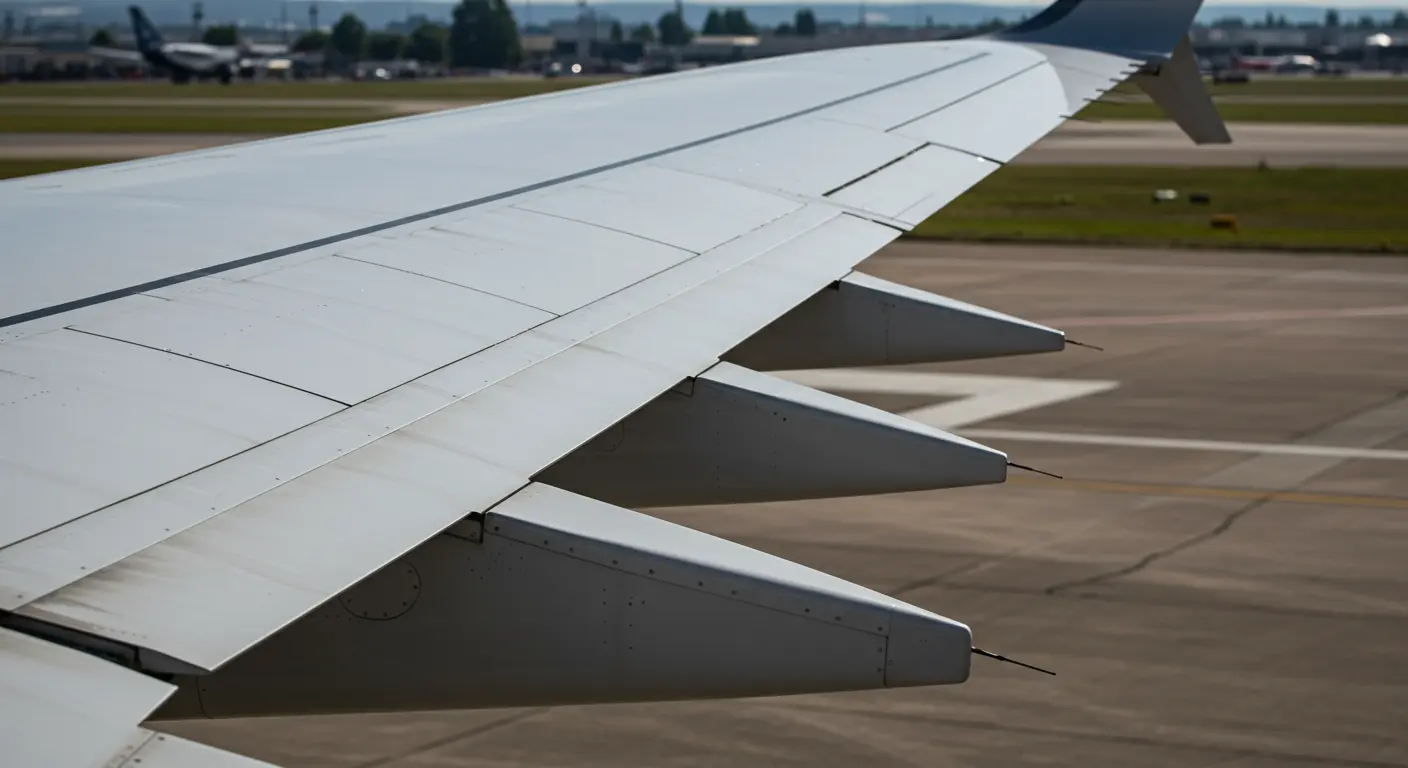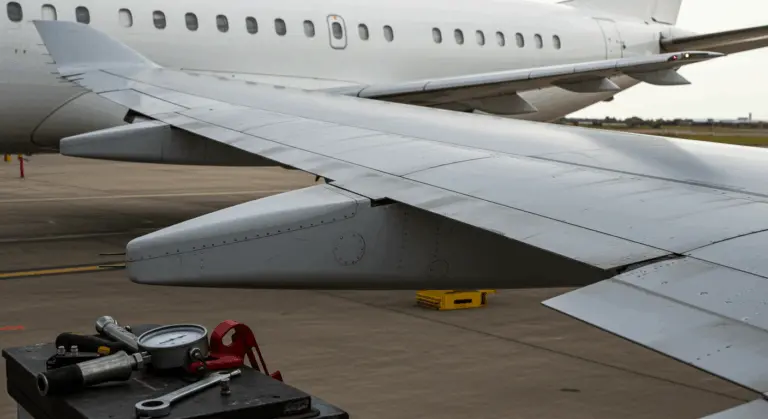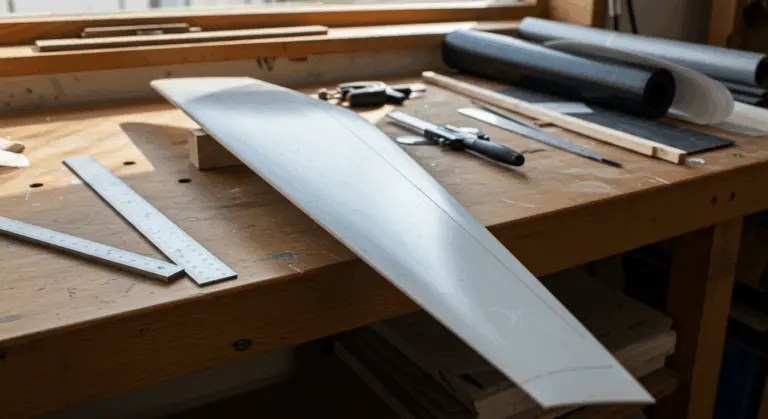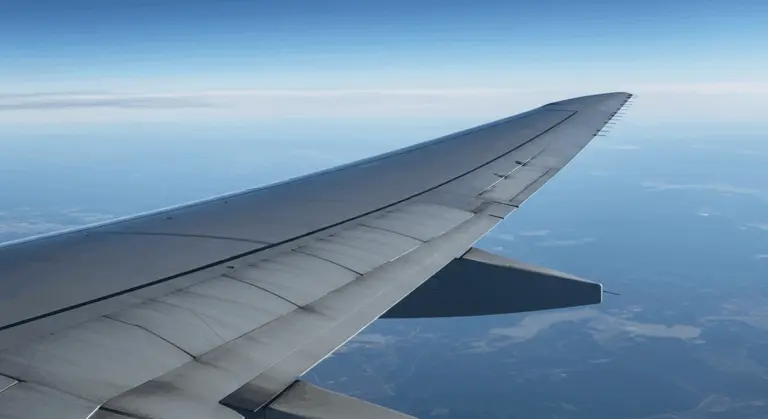Leading Edge Slats – Understanding Their Function and Design
What Are Leading Edge Slats?
Leading edge slats are sophisticated aerodynamic surfaces positioned along the forward portion of an aircraft wing. These specialized devices significantly improve wing performance during critical flight phases—particularly when operating at lower airspeeds. During normal cruise flight, slats remain retracted, lying flush with the wing’s surface to maintain the streamlined profile for optimal high-speed performance. But when the situation demands it, they slide forward from the wing’s leading edge, creating a distinctive gap or slot between the slat and the main wing structure.
This slot creates a powerful aerodynamic effect. High-pressure air from beneath the wing flows through the gap to the upper surface, energizing the airflow and delaying stall onset. The result? Aircraft can fly safely at significantly lower speeds.
You’ll find leading edge slats predominantly on faster aircraft designs, particularly swept-wing jets where engineers must balance high-speed performance with safe low-speed handling characteristics. They work together with trailing edge flaps—slats commanding the leading edge while flaps control the trailing edge. Together, these high-lift devices temporarily transform the wing’s shape and aerodynamic properties, boosting lift during takeoff and landing when aircraft operate at reduced speeds yet require substantial lifting force.
Types of Leading Edge Slats
Leading edge slats come in several distinct configurations, each engineered to meet specific performance demands: fixed, automatic, and powered slats, alongside specialized variations like Krueger flaps and slotted slats.
Fixed slats remain permanently extended from the wing’s leading edge, creating a constant slot that continuously energizes airflow over the wing’s upper surface. While simple and reliable, you’ll typically find these on older or simpler aircraft designs where the aerodynamic penalties during cruise flight are deemed acceptable.
Krueger flaps represent a fascinating twist on traditional leading edge devices. Rather than sliding forward, these clever mechanisms pivot outward from the wing’s undersurface, forming an extension of the leading edge itself. Boeing aircraft favor this design, because Krueger flaps effectively increase both wing camber and area, though they don’t create the same distinctive slot effect as true slats.
Slotted slats create a precisely engineered gap when deployed—a design that has become the gold standard on most modern commercial airliners. Why? Superior stall resistance.
Automatic slats demonstrate elegant engineering. They deploy and retract based purely on aerodynamic forces, requiring no pilot input or powered mechanisms. As the aircraft’s angle of attack increases and airspeed decreases, these devices extend automatically, providing crucial protection against inadvertent stalls. The Handley Page automatic slat stands as a classic example, using aerodynamic pressure differences to control deployment with remarkable precision.
Powered slats dominate modern commercial aircraft, employing hydraulic or electric actuators for precise deployment and retraction control. These sophisticated systems integrate seamlessly with the aircraft’s flight management computers, optimizing slat position based on flight phase, speed, and countless other parameters. This provides optimal performance across the entire flight envelope.
How Leading Edge Slats Operate
Leading edge slats operate through a sophisticated deployment mechanism that fundamentally transforms an aircraft wing’s aerodynamic properties. Unlike leading edge flaps that rotate about a hinge, slats deploy by sliding forward and slightly downward, maintaining a largely parallel orientation to the airstream. This forward movement creates something crucial—a gap, or slot, between the slat and the main wing structure.
When deployed, slats perform two key aerodynamic functions:
-
They increase the wing’s camber (curvature), which enhances lift at low airspeeds.
-
They create a slot that channels high-pressure air from below the wing to the upper surface, re-energizing the boundary layer.
The slot effect produces the primary aerodynamic benefit. As air passes through this carefully engineered gap, it accelerates dramatically, creating a high-energy airstream that hugs the wing’s upper surface. This energized airflow delays boundary layer separation—the culprit behind stalls at high angles of attack. This results in A substantial increase in the wing’s maximum lift coefficient and stall angle, allowing aircraft to maintain controlled flight at significantly slower speeds than would otherwise be possible.
Slats provide the most value during those critical low-speed flight phases: takeoff and landing. During landing approaches, deployed slats allow pilots to maintain superior control at slower airspeeds, enabling steeper descent angles and shorter landing distances. For takeoff operations, slats provide valuable lift enhancement with minimal drag penalty—improving climb performance while reducing required runway length. This favorable lift-to-drag ratio makes slats remarkably efficient compared to other high-lift devices that generate more drag when deployed.
By effectively directing and energizing airflow, leading edge slats solve aviation’s fundamental challenge: maintaining airflow attachment at high angles of attack. This capability transforms the wing’s performance envelope entirely, enabling safe operation across a dramatically wider range of flight conditions.
The Historical Development of Leading Edge Slats
The story of leading edge slats begins with a pivotal moment in aviation history. After German engineer Gustav Lachman survived a stall-related crash in 1917, the experience drove him to patent a revolutionary design in Germany in 1918—one specifically engineered to prevent wing stalls at low airspeeds.
Meanwhile, across the English Channel, British engineer Sir Frederick Handley Page was independently pursuing similar concepts. His research culminated in the slotted wing, operating on principles remarkably similar to Lachman’s slats. This parallel development underscored a universal aviation challenge: early aircraft, with their primitive wing designs, were dangerously prone to stalling.
Early slat implementation was relatively simple—pilots manually deployed them before landing or takeoff. These initial designs were mechanically simple yet remarkably effective, demonstrating significant improvements in low-speed aircraft performance. As aviation technology surged forward through the 1930s and 1940s, engineers continuously refined slat designs, making them more aerodynamically efficient and easier to operate.
World War II accelerated slat technology advancement. As aircraft speeds soared and combat flying demanded enhanced maneuverability across wider speed ranges, innovation accelerated. German aircraft manufacturers took the lead, incorporating advanced slat systems into their fighter designs. The Messerschmitt BF 109 featured automatic leading edge slats that deployed naturally when angle of attack increased—providing pilots with crucial stall protection during high-g combat maneuvers.
The post-war era saw slat technology integrated into commercial aviation, with early jetliners adopting increasingly sophisticated systems. As aircraft grew larger and faster, effective high-lift devices became even more critical for safe operation from existing runways. This period marked a pivotal transition: from simple mechanical slats to hydraulically or electrically powered systems that could be precisely controlled as part of an integrated high-lift strategy, working in coordination with trailing edge flaps to optimize wing performance across all flight regimes.
Leading Edge Slats in Modern Aviation
In today’s aviation landscape, leading edge slats have become standard equipment on high-performance aircraft—particularly swept-wing jets—where they substantially enhance low-speed handling and stall characteristics.
Modern commercial airliners like the Boeing 737 and Airbus A320 families showcase multi-segment slat systems that extend automatically during approach and takeoff configurations. These systems work in carefully calibrated harmony with trailing edge flaps, creating what engineers call the ‘high-lift configuration’—a temporary wing profile that generates substantially more lift than the clean wing designed for cruise efficiency. This combined approach allows aircraft can safely operate at speeds up to 30% slower than would otherwise be possible, enabling shorter takeoff runs and approach speeds.
Beyond traditional deployable slats, modern aviation has embraced innovative variations. Fixed leading-edge extensions (LEX) on fighter aircraft like the F/A-18 Hornet generate powerful vortices that energize airflow over the wing at high angles of attack, substantially enhancing maneuverability. Similarly, some business jets employ specialized Krueger flaps—hinged leading-edge devices that serve a similar function to slats but with deployment mechanics better suited to their specific wing designs.
The integration of slat systems with digital flight control technology has significantly advanced aviation safety. Today’s aircraft feature sophisticated computers that automatically schedule slat deployment based on airspeed, altitude, and countless other flight parameters. These systems eliminate pilot error by ensuring high-lift devices deploy at appropriate times and retract when no longer needed. This eliminates the risk of attempting to cruise with slats extended—a configuration that would devastate fuel efficiency and aircraft performance.
Research and Innovations in Slat Technology
Current research in slat technology focuses on improving performance and efficiency through more sophisticated deployment mechanisms that maximize aerodynamic benefits while minimizing drag penalties.
Material science is advancing slat innovation. Researchers are exploring advanced composite materials offering superior strength-to-weight ratios compared to traditional aluminum components. These advanced composites enable more complex slat geometries that better control airflow while reducing overall aircraft weight. Some experimental designs even incorporate flexible elements that adapt their shape based on airflow conditions—creating truly dynamic aerodynamic surfaces.
Computational fluid dynamics (CFD) has improved slat design by allowing engineers to model complex airflow interactions with unprecedented detail. This technology enables the development of slat profiles that generate maximum lift enhancement with minimal drag penalties. Recent CFD studies have yielded multi-element slat systems that create cascading vortex structures, energizing boundary layers far more effectively than traditional single-element designs.
Future integration of slat systems with broader aircraft control architectures shows promise for the future. Researchers are developing smart slat systems that communicate with other flight control surfaces, creating coordinated responses to changing flight conditions. These integrated approaches aim to further improve stall characteristics while enhancing fuel efficiency through optimized wing performance across all flight regimes. These innovations could reduce runway length requirements by 15-20%, making air travel accessible to smaller airports with shorter runways.







